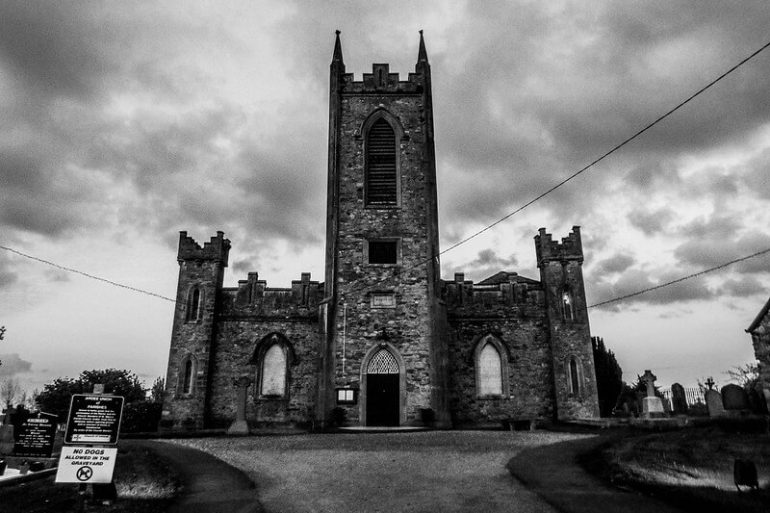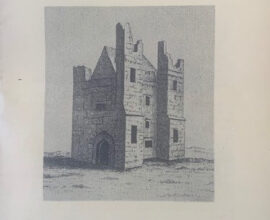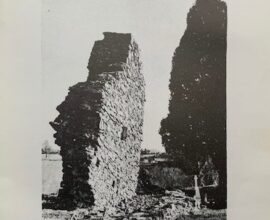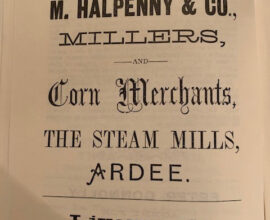Rebellion and Massacres in Ardee and Braganstown (Part 2)
With the dawn of the fourteenth century the people of Ardee awakened to a period of increase lawlessness in Ireland in general and in the areas north of Ardee in particular. Its position on the very frontier between the Norman Lordship and the Gaelic North influenced the way of life of Ardonians as they must have lived a frontier lifestyle. The tenures by which they held their land in both town and the surrounding countryside ensured that they were under an obligation to supply themselves for military service to their overlord and, as we shall shortly see, they were called upon on many occasions to fulfil these duties.
One notorious bandit, who had literally terrorised the people of Ardee on their way to cur turf in the bog, was William MacNeill. Richard Gernon, Sheriff of Louth, managed to capture him one day within the limits of the town. He conveyed him to the constable of Drogheda but MacNeill managed to escape but, fortunately for Ardonians, he was not heard of any more in the area.
The town and surrounding countryside were experiencing two enormous problems. The first of which was that the Gaelic Irish were more and more beginning to attack and harass those residing to the North of Ardee in areas that had come to be known as the Marches. The second problem was created by the large numbers of soldiers that the local lords were beginning to hold on their lands as retainers to thwart the Gaelic incursions. These did not come cheap and it was the local population of Ardee and other such towns that had to foot the bill for this meagre protection.
There is an interesting story told in the Papal Letters where, in November 1317, it seems that Thomas de Mandeville a ‘knight, who was killed at a distance from his parish church, and could not be buried by reason of the power of his enemies, the Prior of Drogheda ordered the body to be buried in their church contrary to the will of the said Knight, none of his ancestors having been buried there’. The Prior of the Ardee St John’s Monastery was instructed to proceed to Drogheda to retrieve the body and to bring it back to Ardee so that the Knight could be buried among his ancestors.
Ardee the Royal Manor
As we have seen previously the effect of the transfer of Ardee land to the King was very much to the advantage of the people of Ardee. From all the surviving documents of this period it is clear that the inhabitants of Ardee referred to themselves as Angli (English) not Normans; and that most of them could trace their family origins to some small Burgess family in one or other of the prosperous English towns of the 13th century.
The townsfolk of Ardee and the surrounding area might well have been happy to transfer their allegiances from the Pippards to the King but they must also have felt in some ways abandoned which is perhaps why they became more aggressive and independent and looked to the development of a Town Corporation as their best means of survival in the harshness that was medieval Ireland.
An example of this new patronage can be seen in the Justiciary Rolls for the last years of Edward I’s reign (27 January 1305). Apparently Ardonians were secure within the town precincts itself but, if they ventured outside the town, they were constantly in danger of attacks by the native Irish, particularly the MacMahons and O’Reillys. Because of this the King ordered that one of the MacMahons be held as a hostage in order that the;
‘Kings men of Ardee may henceforth go securely to the woods in those parts and cut timber and other necessities in the woods without impediment of Gilpatrick and his men’.
In 1306 the Chief Justice issued a Commission to treat with the MacMahons for ‘reformation of the peace’. It would seem that the leader of this tribe wanted to be admitted to the King’s peace and this was granted on the condition that he pay a fine of 60 cows. The livestock was to be brought to Ardee.
It is also worth noting that Ardee was now a Royal Vill and no longer a Manorial Vill as it was under the lordship of the Pippards. Because of this, there were responsibilities that the Townsmen had to carry out. For example, in 1306, when the bridge of Ardee needed to be repaired, the Sheriff maintained that it was the duty of the Burgesses of Ardee to repair the bridge. Because these eminent Ardonian leaders did not carry out these instructions they were imprisoned. This resulted in a lawsuit to the courts of Dublin when a petition of the Burgesses of Ardee complaining of their losses was heard. They stated that neither they nor any of their progenitors were ever accustomed to repair the bridge’. It would seem that this duty used to fall to the Lord of the Manor.
The court ruled that when the Justiciar next visited Ardee that he would more closely look at the problem. In the meantime, however, he asked the Ardonians to repair the bridge as it was badly in need of repair and in danger of falling down. In return for this they could hold on to the pontage (bridge tolls) tax that they were entitled to collect on anybody using the bridge. Of interest here is that they were asked to repair the bridge with stone and lime as stone bridges were very rare in Ireland at this time.
The 1312 rebellion in Uriel.
Tensions between the people of Ardee and their Gaelic neighbours were very high during the early decade of the fourteenth century. This came to a head in 1311 when one of the MacMahon tribe was killed in Ardee by a group of local men led by John Leman. This created a situation where ‘the whole peace of those marches is disturbed, to the common ill of the Englishmen of those parts’. These actions led to an event in history that became known as the de Verdun rebellion of 1312, after its leader Robert de Verdun who had joined with the Gaelic Rebels against the King.
It began in February of that year when the Baronies of Louth and Ardee were attacked by the rebels. By March of 1312 a royal army was advancing against them and an engagement was fought at Ardee where some Notables from the royal army were killed. When the deVerdun rebels withdrew from Ardee the commander of the royal forces, Wogan, sent a detachment of men to guard the ‘Kings Town’ of Ardee.
The town and surrounding area suffered greatly during this rebellion. Many cows and other livestock had been taken from the lands to the north and east of Ardee. Adam le Blound, for example, was to later complain that he had lost over £40 in goods and chattels when his haggard at Stabannon had been burnt.
The rebels, probably because they were of Norman descent, were dealt with very leniently by the government. Some of them, including those from Ardee, were ordered to serve in the King’s armies in Scotland and it was perhaps lucky for them that they arrived in Scotland after the battle of Bannockburn where the King’s forces had been heavily defeated by Robert Bruce who later turned up at Ardee as shall be seen later.
The Bruce Invasion 1315
County Louth in general, and the town of Ardee in particular, endured more intense military activity than the rest of the country when the Scottish noble, Edward Bruce, invaded Ireland in 1315. On 29th June of that year the Scots burned Dundalk and then marched to Ardee which they eventually gained after what was described as a fierce battle with great loss of life on both sides. On entering the town, he took his revenge by herding all the people into the Parish Church (Old Saint Marys) and, after blocking up all the exits, burnt it to the ground with the Ardee townspeople inside.
A contemporary to the proceedings later described this and other events.
On St Peter and Paul’s Day the Scots came to Dundalk, took, plundered and then burnt it, after they had killed all who opposed them. A great part of Uriel was likewise burnt by them, as was also the church of the Blessed Virgin Mary in Ardee (full of men, women and children) by them and the Irish.
All of the Gaelic sources concur that this terrible event did take place in Ardee. The only confusion that remains is to which of the churches of Ardee the people entered before they were killed as both the Parish church and the church attached to the Carmelite Monastery were dedicated to the Blessed Virgin.
A person who accompanied Bruce in Ardee on that fateful day indicated;
Eclesia Beate Marie Virginis de Atrio Dei, plena viris et mulieribus et parvulis. Comburitur a Scotis et Hibernicus.
However, as the chapel in the Carmelite monastery was relatively small it must have been the larger Parish church, where Old St Mary’s is today, where this terrible deed was inflicted on the men, women and children of the town.
His capture of the town was made that much easier because, according to a Gaelic source of the period, it had neither wall or castle. Having captured the town, he almost certainly would have completely sacked it. The three Royal mills were particular targets as they could be used to supply the Norman forces with bread, so the Scots went to great lengths to pull them down. So much so that in an inquisition taken of the state of Ardee manor some years later, indicated that only one of the mills could have been easily restored, the other two were so badly destroyed that it took quite some time for them to be rebuilt.
Two royal armies were quickly dispatched, and these came together and encamped on the hills south of Ardee. Contemporary sources estimated the size of the royal forces to be in the region of 36,000 men so it is not surprising that the Scottish army quickly retreated northwards in the face of this advancing force. A contemporary described the events;
The earle (Richard de Burgo) that night encamped at Athfirdia near the mount called Sliew Brey (Sliabh Breagh), and Edward Bruce with his Scottish and Ulster men at Inis Kaeyne (Inniskeen), the earle the next daye followed him and encamped in the town of Louth’.
The Annals of Clonmacnoise tell us that in 1315 AD Edward Bruce landed and terrified Palesmen. He burnt Dundalk and Ardee and harried and spoiled the area. A Large army marched toward Bruce at Ardee and encamped at Sliew Breg (Sliabh Breagh).
Their retreat was not without incident, however, as the Scots would have burnt anything they could not carry with them in keeping with their scorched earth policy.
In early 1316 the Gaelic tribes of the O’Hanlons used this opportune time to attack the remaining Normans in County Louth. Later in that year Robert Bruce, of Braveheart fame, joined his brother Edward and their combined forces marched as far south as Limerick before once again retreating northwards.
On 14 October 1318 the Scots campaign in Ireland ended when they were defeated at the battle of Faughart. Many Ardonians were present on that fateful day and, by all existing accounts, they fought with bravery and gallantry, perhaps to revenge the massacre of their kinsfolk in the church at Ardee. The Gernon family in particular were set aside for special reward and were granted a fishery on the river Dee in consequence of one of their number having been maimed at the battle at Faughart.
Famine in Ardee 1315-1318
The effects of the Scottish invasion of county Louth were further compounded by the severe famine that was also ravaging the area. The area worst affected was the town of Ardee and the lands to the north of it towards Dundalk. We know this because when the town and manor was granted to Walter de la Pulle in 1325 it was described as lying waste having been destroyed by the Scots and the Gaelic tribes of the north (destruyt per les enemys de Dcotorum et les Ireys de les marches).
Things were just as bad at Benedict Pippard’s manor of Pepperstown (Pippardstown) just to the north of the town. In February 1316, an inquisition found that no tenants could be found for the land because it had been completely burned by the Irish’. What the Scots did not steal I am sure that the royal armies quartered in Ardee would have consumed. The concentration of military forces in the area produced a lot of resentment among the surviving Ardonians as they had to pay much of the cost of the armies that were sent there to protect them from the Scottish threat. That this was so is evidenced by a Gaelic Scribe who accompanied Bruce’s armies. ‘excepting homicide…deeds no less evil were done by an army drawn from different parts of Ireland to do battle with them (the Scots) in the districts through which the units passed’.
De Bermingham Earl of Louth
The people who had returned to Ardee after the first two decades of the fourteenth century looked on disapprovingly as John de Bermingham was rewarded for his campaigns against the Scots by being created Earl of Louth in May 1319. This had the effect of transforming Louth into a Royal County and a Liberty which would inevitably see the introduction of more impositions and taxes that would have to be paid directly to de Bermingham. Further rewards came his way when he was granted the office of Sherriff of the county with power to levy taxes. The only problem was that de Bermingham held no lands in the county of Louth.
As if this was not enough for Ardonians to bear they must have been totally shocked when the King also granted him the Manor of Ardee. He held the position of Lord of Ardee Manor for a few short years only as the King later passed the town to Walter de la Pulle. The earl left his Manor at Ardee moving just over four miles to the north to create a new Manor of Braganstown. By so doing, however he had to evict John de Clinton from what had been his ancestral home since the original Norman invasion. Little did de Bermingham know that when he was re-building his palatial home at Braganstown that it would soon become his tomb when disgruntled Louthmen, including many from Ardee, with scores to settle, descended upon Braganstown with murder on their minds.
Battle of Braganstown.
On the vigil of Pentecost and of Blessed Barnabas the Apostle, Lord John de Birmingham, earl of Louth, is killed, all of his country conspired against him, not wishing that he should rule over them; they took counsel as one and gathered a great multitude of men; sparing none of his family; they killed him with 160 and more, with his two brothers, and about nine of his name.
This is how Friar Clyn, in His Annals of Ireland, described the events that occurred in Braganstown on that fateful day. The events leading up to the murder of the Earl of Louth occurred in the town of Ardee on the 9 and 10 June.
One of the main complaints that Louthmen in general and Ardonians in particular had against de Bermingham was his practice of keeping large numbers of Gaelic foot soldiers, known as Kern. These came from the wilds of Offaly and caused concern everywhere they visited in county Louth but especially among the Ardee Townsmen. A number of Kern had entered Ardee and proceeded to cause trouble in the Streets. When they murdered Robert Goodknave from Ardee a Hue and Cry was immediately raised, and the townspeople quickly formed themselves into a Posse (Posse Comitatus). They killed two of the Kern on the spot and followed the rest of them to the Carmelite Church where they had taken sanctuary. Such was the anger and resentment of these Kerns that the Ardee Posse, ignoring Church Sanctuary, broke in and killed the Kern inside. They then pursued the escaping Kern, who fled to Braganstown, where the Earl, his wife and over 160 people were killed by the Posse from Ardee.
The people from Ardee town and barony who had taken part in the massacre at Braganstown were eventually received back into royal favour. Peter de Haddesore, John deClinton and Richard Taaffe served as Sheriffs of Louth. Richard Taaffe, John and Gerard Clinton were requested by the King to fight with him in his Scottish campaigns of 1335.




